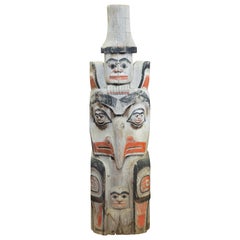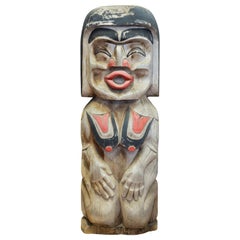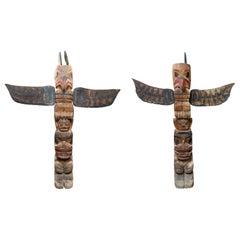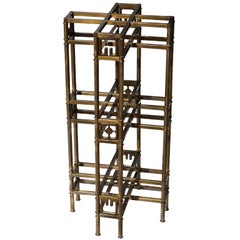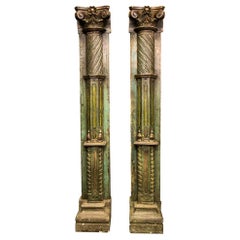Native American Art Pedestals and Columns
7
to
7
7
7
7
7
2
2
3
2
1
1
Height
to
Width
to
7
7
7
7
8
7
7
6
5
Creator: Native American Art
Salish Carved Cedar TOTEM
By Native American Art
Located in Coeur d'Alene, ID
Salish TOTEM depicting a human wearing a potlatch hat perched between the ears of an eagle at top, a human face in relief for the birds eyes, a small humanoid/bird figure standing at...
Category
Late 20th Century American Native American Native American Art Pedestals and Columns
Materials
Cedar
Northwest TOTEM
By Native American Art
Located in Coeur d'Alene, ID
Northwest totem with whale, man figure (possibly prominent individual within the tribe or society where the hands are shown in a holding position which...
Category
1930s American Native American Vintage Native American Art Pedestals and Columns
Materials
Cedar
Doug Lafortune Sr. Salish Carved Wood and Abalone TOTEM Pole
By Native American Art
Located in Coeur d'Alene, ID
72" TOTEM by Doug Lafortune. Salish TOTEM pole of a raven and beaver cedar TOTEM pole. Carved TOTEM pole with abalone and shell inlays. Carved. .72” x 9...
Category
1950s American Native American Vintage Native American Art Pedestals and Columns
Materials
Cedar
Tsonoqua/Dzunkukwa "Wild Woman of the Woods" Totem
By Native American Art
Located in Coeur d'Alene, ID
Tsonoqua/Dzunukwa, “The Wild Woman of the Woods,” is an important ancestor figure to the Kwakwaka’wakw people of British Columbia. A giantess that fills important cultural roles during the potlatch, she is best known as a wealth-bringing being to those who encounter her and as a creature that parents tell their children stories about to make them behave and not venture far from the village – as she is also a cannibal and has been known to snatch stray children from the woods. She is the female counterpart of the male Bak’was, the Kwakwaka’wakw “Wild Man of the Woods.” Tsonoqua is analogous to the Coast Salish Sasq’ets, better known as Sasquatch, the Nuxalk Sniniq (female) and Buks (male), the Tsimshian Ba’oosh, the Haida Gagiit, the Athabaskan Hairy Man (or Woman), and the Tlingit Tl’anaxéedáakw. She is also what a lot of folks would call Bigfoot.
This pole is carved in a Coast Salish style but shows several Kwakwaka’wakw influences, so is perhaps better termed a female Sasq’ets pole. This pole shares a lot of stylistic elements with work by the Coast Salish Horne family and was perhaps carved by one of them. The features of the face that identify this pole as a Wild Woman are the tightly squinted eyes, the prominent cheekbones, and the pursed red lips that depict her making her telltale whistling call. Large breasts are created by “split-u” formline elements on her chest, motifs which are repeated (unpainted) on her arms and legs. Her hands and appropriately large feet are rendered naturalistically, and she is depicted in a kneeling position. A very fine example of Northwest Coast carving.
Period: Last quarter 20th century
Origin: Salish
Size: 49"H x 17'W.
Family Owned & Operated
Cisco’s Gallery deals in the rare, exceptional, and one-of-a-kind pieces that define the history of America and the Old West. Our pieces range from American Indian to Cowboy Western and include original items of everyday life, commerce, art, and warfare that tamed America’s frontier. Our 14,000 square foot gallery opened in 1996 in beautiful Coeur d’Alene, Idaho.
Personal Service
Cisco’s operates on old fashioned values – honesty and integrity, and all of our items are backed by our money back guarantee. We appreciate the opportunity to earn your business. Whether you desire assistance with a jewelry purchase, choosing a gift, identification, or even selling – we hope to be your trusted source.
Native American, Carving, Totem, Pole, Painted, Cedar, Salish Indian
Category
Late 20th Century American Native American Native American Art Pedestals and Columns
Materials
Cedar
Monumental Makah TOTEM by Young Doctor 108"H
By Native American Art
Located in Coeur d'Alene, ID
Makah TOTEM by Young Doctor (1851-1934). Neah Bay, Washington. This monumental pole is a significant piece of Northwest Coast art and Seattle history that was previously owned by Joseph Edward “Daddy” Standley, the founder of the iconic Ye Olde Curiosity Shop in Seattle, Washington. The pole was displayed for years on the grounds of Standley’s “TOTEM Place” estate in West Seattle, across the bay from his iconic ethnographic art and curio shop on the Seattle Waterfront. So popular amongst tourists was the TOTEM Place estate grounds, that the Southwest Seattle Historical Society has stated that “for decades... it was a place where tour buses stopped, and flashbulbs popped. It probably was the most gawked-at, talked-about residence in West Seattle.”
This pole was even featured in situ at Standley’s West Seattle home on a postcard that was sold to visitors through Ye Olde Curiosity Shop. While there are multitudes of model poles and other artifacts available to collectors that were sold as souvenirs from Ye Olde Curiosity Shop, objects that were actually owned by Standley are virtually unknown in the art market. The vast majority of objects that Standley esteemed and considered his private collection have remained with his family and descendants and are on permanent display in the store.
Among the objects owned by Standley to make their way into the Smithsonian was a Spirit Canoe sculpture by Makah master carver Young Doctor (1851-1934), the likely carver of this pole. It would appear that Standley and Young Doctor had a good working relationship as a number of pieces, including this TOTEM, an elaborate transformation mask, the aforementioned Spirit Canoe model at NMAI, and a full model set of a Makah whaling crew and canoe were made for Standley by the artist. This large-scale TOTEM pole is an exceptional example of turn-of-the-20th-century Northwest Coast carving...
Category
Early 1900s American Native American Antique Native American Art Pedestals and Columns
Materials
Cedar
Massive Pair Native Salish Carved Totems
By Native American Art
Located in Coeur d'Alene, ID
Matched pair of Salish Native American totem poles. Both identical. Carved as a thunderbird with spread rings separately carved and attached perched on the head of a human over a sea...
Category
Late 20th Century American Native American Native American Art Pedestals and Columns
Materials
Cedar
Multi-Figure 7 Foot Nuu-chah-nulth TOTEM
By Native American Art
Located in Coeur d'Alene, ID
This large pole was “donated to a church on the northern tip of Vancouver Island for a fundraiser” sometime around 1905. The pole is carved in a folk-art style that is correct for the period. The imagery on this pole is quite fascinating and includes a large bird whose wings form the face of a composite creature holding what appears to be a whale or fish. Below that is what appears to be a Sisiutl, or three-headed sea serpent. Under the Sisiutl is a pair of animal heads flanking the pole, perhaps wolves, over a colonial bald eagle. This pole is a large and early Nuu-chah-nulth totem carving...
Category
Early 1900s American Native American Antique Native American Art Pedestals and Columns
Materials
Cedar
Related Items
Architectural Patinated Brass Pedestal by Mastercraft
By Mastercraft
Located in Kilmarnock, VA
Stunning Architectural plant stand or pedestak made in solid patinated brass by Mastercraft. This is the first and only one I've ever seen. Still has the Original tag attached.
Category
1970s American Vintage Native American Art Pedestals and Columns
Materials
Brass
Pair of Carved and Painted Pilasters
Located in Wilson, NC
These pilasters are from India and have carved stone bases. The upper sections have opposing left and right carved fluted spiral shapings supporting stylized Corinthian capitals. The...
Category
1850s Indian Antique Native American Art Pedestals and Columns
Materials
Stone
19th Century Marquetry Inlaid Pedestal, in the Style of 'Linke'
By François Linke
Located in Brighton, Sussex
A very good quality late 19th century French marble topped classical pedestal, having its original marble top, wonderful elegant gilded ormolu mounts, fine quality marquetry inlaid f...
Category
Late 19th Century French Louis XVI Antique Native American Art Pedestals and Columns
Materials
Ormolu
Inuit Native American Eskimo Signed Stone Carved Walrus Sculpture
By Native American Art
Located in Studio City, CA
A wonderful soapstone carving of a walrus by the indigenous Inuit People who inhabit parts of the arctic regions of Greenland, Canada, and Alaska.
Signed ("E.Y.") and numbered/dat...
Category
Mid-20th Century Canadian Native American Native American Art Pedestals and Columns
Materials
Soapstone
Rare Large Early Native American Northwest Coast Salish Basket
By Salish Indians
Located in Bradenton, FL
Rare large early Northwest Coast Salish hard burden basket dating from the mid to late 1800's. The basket is finely woven from split cedar bark and root...
Category
Late 19th Century American Native American Antique Native American Art Pedestals and Columns
Materials
Hide
Pair of Carved Wood Squared Pedestal Columns
Located in Atlanta, GA
A pair of vintage American carved wood pedestal columns. This pair of bleached wood columns feature squared bodies with a single raised panel at each side, stacked molding just benea...
Category
20th Century American Native American Art Pedestals and Columns
Materials
Wood
Vintage Pueblo Native American Old Pawn Ingot Silver Bracelet, Turquoise c. 1915
By Native American Art
Located in Denver, CO
Vintage Southwestern Native American Pueblo Old Pawn cuff bracelet, circa 1915. Stamped ingot silver with a turquoise cabochon. The inner bracelet circumference measures approximatel...
Category
Early 20th Century American Native American Native American Art Pedestals and Columns
Materials
Multi-gemstone, Silver
Inuit Native American Eskimo Signed Large Stone Carved Tusked Walrus Sculpture
By Native American Art
Located in Studio City, CA
A wonderful soapstone large, heavy carving of a tusked walrus by the indigenous inuit people who inhabit parts of the Arctic regions of Greenland, Canada, and Alaska.
Signed on th...
Category
Mid-20th Century Canadian Native American Native American Art Pedestals and Columns
Materials
Soapstone
H 6 in W 15 in D 6.5 in
Pair of Small Kachina Katsina Dolls Hand Carved Decorated Signed by Artist
By Native American Art
Located in Studio City, CA
A wonderfully detailed and decorated pair of miniature Kachina dolls.
Signed by the artist on the base of one doll.
From a collection of Native American objects and artifacts.
...
Category
20th Century American Native American Native American Art Pedestals and Columns
Materials
Leather, Feathers, Wood, Paint
Architectural Corinthian Carved Wood Capital
Located in Stamford, CT
Architectural carved wood Corinthian capital with nicely distressed patina. A solid piece of wood hand carved into a beautiful Corinthian capital, probably early to Mid-20th Century....
Category
Early 20th Century Native American Art Pedestals and Columns
Materials
Wood
Carved Corinthian Limestone Capital
Located in Richmond, VA
Early 20th Century. Perfect size for table top. Buff color with nice hand carved work.
Category
Early 20th Century European Native American Art Pedestals and Columns
Materials
Limestone
Historic Laguna Pueblo Large Native American Olla, 1880's
By Native American Art
Located in Phoenix, AZ
Large Laguna Pueblo Indian Polychrome Olla, circa 1880's. Measures 12 5/8"h x 13"w.
Featuring Geometric Designs on the Shoulder and Floral Designs with...
Category
Late 19th Century Native American Antique Native American Art Pedestals and Columns
Materials
Clay
Native American Art pedestals and columns for sale on 1stDibs.
Native American Art pedestals and columns are available for sale on 1stDibs. These distinctive items are frequently made of wood and are designed with extraordinary care. There are many options to choose from in our collection of Native American Art pedestals and columns, although brown editions of this piece are particularly popular. Prices for Native American Art pedestals and columns can differ depending upon size, time period and other attributes — on 1stDibs, these items begin at $9,500 and can go as high as $75,000, while a piece like these, on average, fetch $18,000.
Questions About Native American Art Pedestals and Columns
- 1stDibs ExpertOctober 12, 2021A Native American artifact is any object that provides insight into the lives and history of native people in America. These items range from carved stone pipes, weapons for hunting, tools for cooking, pottery, jewelry and more. Find a collection of artifacts on 1stDibs today.
- 1stDibs ExpertApril 5, 2022What Native Americans used to produce baskets varied from tribe to tribe. Generally, craftsmen used whatever materials were readily available. In the Northeast, sweet grass was a common material, while pine needles and wicker are frequently found in baskets produced by tribes in the Southeast. Find a range of vintage and antique baskets on 1stDibs.
- 1stDibs ExpertApril 5, 2022In the Native American language of Powhatan spoken by the Algonquian indigenous people, moccasin refers to a hand-sewn suede bootie. Today, people may call any shoes that feature stitched round toes by the name. Shop a variety of moccasins on 1stDibs.
- 1stDibs ExpertApril 5, 2022There are a wide array of different dolls made by the various tribes of Native American peoples. Some of the most well-known are the kachinas made by the Navajo, Hopi and Pueblo peoples. Shop an array of Native American dolls on 1stDibs.
- 1stDibs ExpertApril 5, 2022The most well-known Native American blankets come from Navajo weaving, which are prized by collectors worldwide. Originally utilitarian, the Navajo people began creating blankets specifically for export and tourism in the 19th century. Shop a collection of Navajo blankets from some of the world’s top sellers on 1stDibs.
- 1stDibs ExpertApril 5, 2022What Native American drums are called varies by type. Ones designed to rest in the player's lap are hand drums, while instruments that hold water used primarily by the Iroquois and Yaqui are water drums. Large freestanding drums that produce loud percussive sounds are powwow drums. The Aztec and Hopi used foot drums. You'll find a range of Native American drums on 1stDibs.
- 1stDibs ExpertApril 5, 2022Native American slippers are called moccasins. Moccasins are characterized by their U-shaped puckered toe design and are crafted with various leathers such as sheepskin or buffalo. They may or may not be decorated with beading. Shop a collection of authentic moccasins from some of the world’s top sellers on 1stDibs.
- 1stDibs ExpertApril 5, 2022It depends on which region the beads were made since they were created out of available materials found in the land around them. In the Eastern Woodlands, white and purple marine shell beads were called “wampum”. You can shop a collection of Native American beadwork from some of the world’s top boutiques on 1stDibs.
- 1stDibs ExpertApril 5, 2022To identify Native American baskets, you can research the patterns using authoritative online resources to try and determine which tribe produced it. However, many replicas exist and there are many tribes that produced baskets. As a result, it is a good idea to consult a licensed appraiser. On 1stDibs, find a variety of expertly vetted Native American baskets.
- 1stDibs ExpertApril 5, 2022What a Native American headdress represents depends on what tribe produced it. In general, headdresses may symbolize a person's status within the tribe or serve as a sign of bravery during battle. You'll find a selection of Native American headdresses on 1stDibs.
- 1stDibs ExpertApril 5, 2022To tell if Native American jewelry is real, have it evaluated by a licensed and experienced appraiser. Because every tribe has its own designs and identifying characteristics, it is usually not possible to determine authenticity using only online resources. Find a collection of expertly vetted Native American jewelry on 1stDibs.
- 1stDibs ExpertMay 5, 2023A number of Native American tribes are known for pottery, including the Cheyenne, Cherokees, Hopi, Iroquois, Navajo Pueblo and Shoshone. Artisans from each indigenous group have their own style. For example, Hopi pottery is often a red-brown color and decorated with black designs, while Navajo pottery is deeper brown and usually has a high-gloss finish. Find a selection of Native American pottery on 1stDibs.
- 1stDibs ExpertApril 5, 2022What rattles symbolize in Native American culture varies from tribe to tribe. Some indigenous people believe they serve as connections between the natural and spiritual worlds. Others believe they represent the ties between animals, plants and minerals. In addition, rattles sometimes symbolize independence. On 1stDibs, find a selection of Native American rattles.
- 1stDibs ExpertApril 5, 2022Northwest Coast native art describes works of art produced by indigenous people who live along the Northwest Coast of the U.S. and Canada. Some tribes who inhabit the region include the Haida, Heiltsuk, Kwakwaka'wakw, Nuu-chah-nulth, Nuxalk, Tlingit and Tsimshian. On 1stDibs, find a collection of Northwest Coast native art.
- 1stDibs ExpertApril 5, 2022The two types of Native American beadwork are called the “lazy stitch” or “lane stitch” and the “tack stitch” or “flat stitch”. You can shop a collection of Native American beadwork from some of the world’s top boutiques on 1stDibs.
Recently Viewed
View AllMore Native American Art Furniture
Native American Art Folk Art
Native American Art Decorative Objects
Native American Art Rugs and Carpets
Native American Art Musical Instruments
Native American Art Decorative Baskets
Native American Art Historical Memorabilia
Native American Art Models and Miniatures
Native American Art Collectible Jewelry
